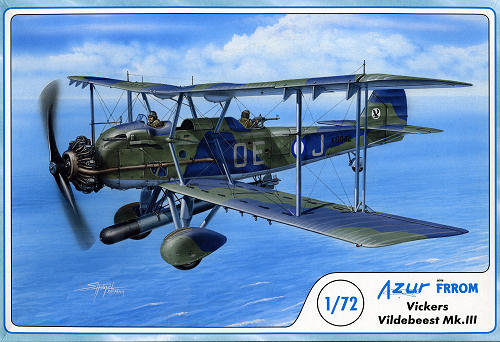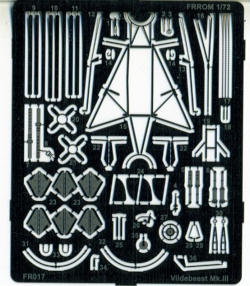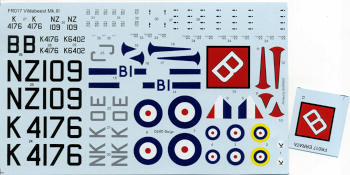
Azur/Fromm 1/72 Vickers Vildebeest Mk.III
| KIT #: | FR 017 |
| PRICE: | CDN $39.00 from www.westcoasthobbys.com |
| DECALS: | Four options |
| REVIEWER: | Scott Van Aken |
| NOTES: | New tool multi-media kit |

| HISTORY |
The Vickers Vildebeest and the similar Vickers Vincent were two very large two- to three-seat single-engined British biplanes designed and built by Vickers and used as a light bomber, torpedo bomber and in the army cooperation roles. While first flown in 1928, it remained in service at the start of the Second World War, with the last Vildebeests flying against Japanese forces over Singapore and Java in 1942.
Designed against Air Ministry Specification 24/25 for the RAF, for a land-based torpedo bomber to replace the Hawker Horsley, the prototype Vildebeest, the Vickers Type 132, was first flown in April 1928, powered by a Bristol Jupiter VIII radial engine. After initial evaluation, the Vildebeest was shortlisted for evaluation with the Blackburn Beagle and Handley Page Hare. As the Jupiter VIII was prone to vibration, a second prototype, the Vickers Type 204 was fitted with a Armstrong Siddeley Panther engine, and after further testing, the Vickers design was confirmed as the winner of the contest. Engines problems continued, however, which were solved by fitting a new version of the Jupiter, which later became known as the Bristol Pegasus.
The Vildebeest had an all-metal, fabric-covered airframe, with single-bay unstaggered wings. An initial production order was placed in 1931 for nine aircraft, with the first production aircraft flying in September 1932. More production followed, with major production being of the Vildebeest III version, which added a third crewmember, with 150 built for the RAF. The Mark IV introduced the much more powerful (825 hp (615 kW)) Bristol Perseus Sleeve valve radial engine enclosed in a NACA cowling, which significantly improved performance, maximum speed increasing to 156 mph (251 km/h) and rate of climb to 840 ft/min (4.3 m/s). The Perseus had overheating problems, and was unsuitable for tropical service, and production was limited to 18 aircraft, which served with the home based squadrons.
| THE KIT |
 It
is great to see an aircraft such as this finally being released as an injected
plastic kit. Thanks to the different variants and the similar Vincent, I'd be
willing to bet that other kits will soon appear.
It
is great to see an aircraft such as this finally being released as an injected
plastic kit. Thanks to the different variants and the similar Vincent, I'd be
willing to bet that other kits will soon appear.
Most of the kit is molded in a nicely done grey
plastic. Detailing is excellent and I found no molding glitches on any of the
parts. Resin is used for the engine, control stick, rudder pedals and a few
other items. The very
 well done
photo etch fret is for things like the seat harnesses, tail plane struts, some
gun bits and quite a few items for the torpedo and the flight control actuating
rods and levers.
well done
photo etch fret is for things like the seat harnesses, tail plane struts, some
gun bits and quite a few items for the torpedo and the flight control actuating
rods and levers.
The inside of the fuselage halves are well detailed with framework representations. When done, the cockpit and gunner's positions will also be very nicely detailed, though there won't be a ton than can be seen through the rather small openings. Still, it is nice to know that all that framing is provided for the penlight crowd. Another option is for spatted or open wheels, and this will depend on the markings option that one chooses. The aircraft isn't as rigging intensive as one would initially believe. The instructions provide an excellent rigging diagram to help make things easy for the builder.
Markings are given for four aircraft. The box art
plane is with 36 Squadron in Singapore during early 1942. It is in the sea
scheme that consists of two shades of Sea Green and two shades of Mediterranean Blue over Sky Blue. A
similarly colored plane with 100 Squadron, also at Singapore at the start of the
war is provided. There are two overall Aluminum Dope planes. One with the New
Zealand AF in 1941 and one with a large 'B' on the upper wing at Singapore with
36 Squadron in 1936. An addendum bit with the proper size 'B' for the wing is
provided. Decals are superbly done by DEAD Design. Color references by Gunze are
provided and at least one will need mixed. Though the shades are not really
standard in most paint lines, the dedicated modeler should be able to find
these.
shades of Sea Green and two shades of Mediterranean Blue over Sky Blue. A
similarly colored plane with 100 Squadron, also at Singapore at the start of the
war is provided. There are two overall Aluminum Dope planes. One with the New
Zealand AF in 1941 and one with a large 'B' on the upper wing at Singapore with
36 Squadron in 1936. An addendum bit with the proper size 'B' for the wing is
provided. Decals are superbly done by DEAD Design. Color references by Gunze are
provided and at least one will need mixed. Though the shades are not really
standard in most paint lines, the dedicated modeler should be able to find
these.
| CONCLUSIONS |
Overall, a fine looking kit that should make into a most interesting model of a little known pre-war biplane bomber. Stay tuned for a full build article.
| REFERENCES |
http://en.wikipedia.org/wiki/Vickers_Vildebeest
July 2011
Thanks to
www.westcoasthobbys.com for the preview kit. Pick yours up today from the
link. If you would like your product reviewed fairly and quickly, please
contact
me or see other details in the Note to
Contributors.